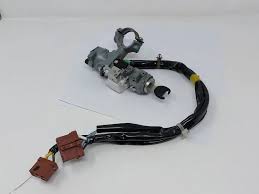In the realm of compact cars, the 2000 Honda Civic has carved out a reputation for its reliability, efficiency, and enduring popularity. At the core of its ignition system lies a critical component: the ignition switch. In this blog, we’ll delve into everything you need to know about the ignition switch in the 2000 Honda Civic, including its function, common issues, maintenance tips, and replacement guidelines, to ensure smooth and reliable starts for your Civic for years to come.
Understanding the Ignition Switch in the 2000 Honda Civic
Function:
The ignition switch serves as the primary interface between the driver and the vehicle’s electrical system. It is responsible for initiating the starting process by sending electrical power to various components, including the starter motor, fuel pump, and ignition system, when the key is turned.
Components:
The ignition switch in the 2000 Honda Civic consists of several key components, including the ignition lock cylinder, electrical contacts, and switch mechanism. When the key is inserted into the ignition lock cylinder and turned, it activates the switch mechanism, allowing electrical current to flow through the contacts and energize the starter motor and other essential systems.
Common Issues with the Ignition Switch
Electrical Malfunctions:
One of the most common issues with the ignition switch in the 2000 Honda Civic is electrical malfunctions, such as intermittent starting, failure to start, or loss of power to certain electrical components. This can be caused by worn contacts, loose connections, or internal damage to the switch mechanism.
Key Sticking or Jamming:
Another common issue is key sticking or jamming in the ignition lock cylinder, making it difficult or impossible to turn the key and start the vehicle. This can be caused by worn or damaged key tumblers, dirt and debris buildup, or internal wear and tear.
No Start Condition:
A no-start condition, where the engine fails to crank or start when the key is turned, can also indicate a problem with the ignition switch. This can be caused by a faulty switch mechanism, electrical issues, or problems with the starter motor or related components.
Maintenance Tips for the Ignition Switch
Key Care:
Handle the ignition key with care and avoid forcing it into the ignition lock cylinder. Use a designated keychain to prevent unnecessary stress on the key and ignition switch, and avoid hanging heavy or bulky items from the keychain.
Regular Lubrication:
Periodically lubricate the ignition lock cylinder and key with graphite or silicone-based lubricant to prevent sticking or jamming. Avoid using oil-based lubricants, as they can attract dirt and debris and worsen the problem.
Electrical Inspection:
Inspect the electrical connections and wiring associated with the ignition switch regularly for signs of corrosion, damage, or wear. Clean and tighten any loose connections, and replace damaged wiring or connectors as needed to ensure proper electrical continuity.
Replacement Guidelines for the Ignition Switch
Signs for Replacement:
Replace the ignition switch in your 2000 Honda Civic if it exhibits any of the following signs:
- Intermittent starting or failure to start
- Key sticking or jamming in the ignition lock cylinder
- No-start condition despite a fully charged battery and functioning starter motor
- Loss of power to certain electrical components, such as the radio, lights, or accessories
Replacement Procedure:
- Disconnect the Battery: Disconnect the negative terminal of the battery to prevent accidental electrical shorts or damage during the replacement process.
- Remove the Steering Column Cover: Remove the screws or bolts securing the steering column cover and carefully pry it apart to access the ignition switch assembly.
- Disconnect Wiring Connectors: Locate the wiring connectors attached to the ignition switch and disconnect them carefully to avoid damaging the connectors or wiring.
- Remove the Ignition Switch Assembly: Remove the retaining screws or bolts securing the ignition switch assembly to the steering column, and carefully extract the assembly from the steering column.
- Install the New Ignition Switch: Install the new ignition switch assembly into the steering column, aligning it properly with the mounting holes. Secure the assembly with the retaining screws or bolts.
- Connect Wiring Connectors: Reconnect the wiring connectors to the new ignition switch assembly, ensuring proper alignment and seating of the connectors.
- Reassemble the Steering Column Cover: Reassemble the steering column cover and secure it with the screws or bolts removed earlier.
- Reconnect the Battery: Reconnect the negative terminal of the battery and tighten the terminal securely to restore power to the vehicle.
- Test the Ignition Switch: Insert the ignition key into the lock cylinder and turn it to the “on” position to verify proper operation of the ignition switch and associated electrical systems.
Conclusion
The ignition switch is a vital component of the starting system in the 2000 Honda Civic, ensuring reliable starts and smooth operation of essential electrical components. By understanding its function, recognizing common issues, and following proper maintenance and replacement guidelines, you can ensure that your Civic’s ignition switch continues to provide reliable performance and trouble-free operation for miles to come. Regular inspection, key care, lubrication, and timely replacement of worn or faulty components are key to maintaining safe and reliable starts and enjoying the full benefits of your Honda Civic’s ignition system.










